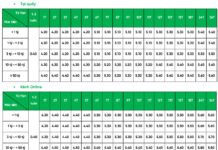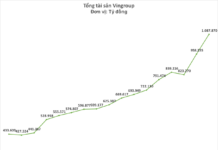Mr. Jens Lottner, CEO of Techcombank, representing the banking sector, shared insights with nearly 150 global investors about the industry’s growth prospects. He emphasized the bank’s commitment to partnering with the government to drive innovation and contribute to Vietnam’s long-term economic development, thereby attracting high-quality international capital.
Techcombank (HOSE: TCB) is renowned for its comprehensive financial ecosystem. Currently, it leads in market capitalization among privately listed commercial banks, boasts the highest CASA ratio, operational efficiency, and asset quality in the industry. Its capital adequacy ratio (CAR) stands at 15.8%, with one of the lowest non-performing loan ratios in the market.
During the panel discussion, Mr. Jens outlined Techcombank’s development strategy, its sustainable competitive advantages, and growth prospects as Vietnam enters a transformative phase.

Three Pillars: Digitalization, Data, and Talent
After over five years with the bank, what do you consider the key factor behind Techcombank’s success?
CEO Jens Lottner: The first core factor is people. Techcombank has built a high-quality workforce, blending local and international talent. Alongside domestic recruitment, we actively hire international professionals and attract Vietnamese talent from Silicon Valley, Los Angeles, Singapore, Sydney, Paris, and London. Coupled with comprehensive training, Techcombank has become a hub for top talent, offering an average income 50% higher than peers and attractive benefits. For Techcombank, Talent is the foundation for leveraging the other two pillars: digitalization and data.
On digitalization, Techcombank heavily invests in technology, prioritizing a cloud-first strategy. Currently, 60% of its tech infrastructure is cloud-based, far exceeding the 20% industry average. This enables scalable growth without increasing operational staff, resulting in a 2.5x customer increase over five years with optimized marginal costs.
On data, processing over 8 billion customer data points daily, Techcombank creates detailed profiles with 12,000 attributes per customer. This data enhances CRM and digital marketing, improving customer experience and business efficiency.
As the industry leader in efficiency, with a cost-to-income ratio (CIR) of around 30%, is there room for further improvement?
CEO Jens Lottner: Currently, 40% of Techcombank’s revenue comes from digital channels, with operating costs 10-15 percentage points lower than the current CIR. Theoretically, costs could be reduced further, but Techcombank prioritizes investment. Over the next five years, the bank plans to invest over $1 billion in technology, marketing, and employee compensation. We are confident in maintaining a 30% CIR while ensuring sustainable growth, even under margin pressure.

Mr. Jens Lottner, CEO of Techcombank
Unreplicable Competitive Advantages
Techcombank excels in both retail and corporate banking, rare in Vietnam. What is the bank’s long-term vision for these segments?
CEO Jens Lottner: Techcombank aims to serve Vietnam’s rapidly growing middle class. Currently, the loan portfolio is 55-60% corporate and 40-45% retail, but this will reverse in the next five years, with retail dominating. As GDP per capita reaches $6,000-$7,000, individual asset accumulation and consumer lending will surge, driving retail growth.
Some say Techcombank relies heavily on real estate. Will this change in the future?
CEO Jens Lottner: Excluding mortgage loans, real estate accounts for about one-third of Techcombank’s loan portfolio. This will decrease to 20-25% as part of the bank’s credit diversification strategy. Historically, we funded premium projects in Hanoi and Ho Chi Minh City, but land in these areas is scarce. Techcombank will shift to infrastructure and boost unsecured lending and retail products to maintain net interest margins (NIM).
How does Techcombank maintain its edge in a competitive market?
CEO Jens Lottner: Techcombank’s advantage rests on three key factors. First, its low-cost funding, with a leading CASA ratio, reduces capital costs. Second, it holds the highest transaction share on Napas, solidifying its position as a top transaction bank. Third, robust risk management keeps non-performing loans low.
In real estate, for instance, Techcombank’s NPL ratio has been 0% over the past decade. This is due to a risk-optimized model that funds projects, not developers, ensuring completion and customer delivery. Many aim to replicate this, but few succeed.
Additionally, corporate culture and investment in strategic pillars are hard to replicate. While many banks grant branch managers full autonomy, Techcombank centralizes data and analysis, ensuring consistency and efficiency. Investing $500 million in technology is challenging, but fostering a culture of compliance is even harder. These are Techcombank’s significant advantages.

Sustainable Growth and Capital Market Opportunities
What is Techcombank’s credit growth target for the next 2-3 years?
CEO Jens Lottner: Assuming 8% GDP growth and 3-4% inflation, nominal GDP growth is 12%. With a credit multiplier of 1.5, industry credit growth could reach 18%. Techcombank targets over 20% credit growth, exceeding the average, by focusing on retail and risk management.
Beyond credit growth, what drives net interest income (NII) and non-interest income (NFI) growth?
CEO Jens Lottner: With 20% credit growth, NII grows accordingly. NIM may face slight pressure, but the bank can maintain over 4% NIM in this market.
Non-interest income (NFI) is also crucial, contributing 22% to total operating income, far above the industry average (below 10%).
This growth is driven by our early development of investment banking. The bank operates many fee-based products, offering significant NFI growth potential.
Moving forward, Techcombank will develop an “originate-to-distribute” model in the bond market, leveraging capital market growth while supporting economic development.
What is the current unsecured lending ratio, and how will it evolve?
CEO Jens Lottner: Unsecured lending currently accounts for 3% of the portfolio but could rise to 11-12% soon. Technological advantages have enabled us to use alternative credit assessment methods, targeting 6.5 million business households in Vietnam. Techcombank serves 2.5 million such customers, with 700,000 eligible for loans based on transaction data. This is a strategic direction for portfolio diversification and sustainable growth.
Additionally, Vietnam’s financial investment products have significant growth potential, especially through product diversification. Techcombank’s entry into insurance and digital assets aims to create a comprehensive financial ecosystem, helping customers manage finances, grow assets sustainably, and accumulate wealth effectively.
ACB Partners with Ho Chi Minh City Tax Department to Lead Support for Business Households Transitioning Under Decision 3389/QĐ-BTC
ACB (Asia Commercial Bank) has officially partnered with the Ho Chi Minh City Tax Department to launch a comprehensive solution tailored for business households during the transition phase under Decision 3389/QD-BTC. This pioneering initiative by ACB aims to empower business households, alleviating the pressures of change, optimizing operations, and fostering business expansion.
Streamlined Property Ownership Declaration: Simplifying the Process for Citizens
The new decree from the Ministry of Construction mandates citizens and businesses to provide housing information to complete the national database. While experts support the digitization initiative, they caution against redundancy, emphasizing the need to leverage existing data and prevent digital transformation from becoming a bureaucratic burden for the public.










































